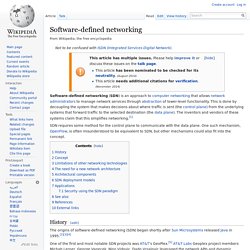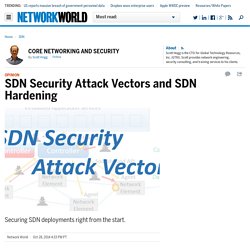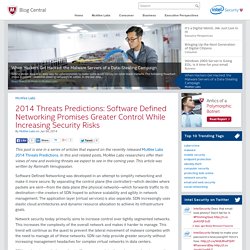

Software-defined networking. Software-defined networking (SDN) is an approach to computer networking that allows network administrators to manage network services through abstraction of lower-level functionality.

This is done by decoupling the system that makes decisions about where traffic is sent (the control plane) from the underlying systems that forward traffic to the selected destination (the data plane). The inventors and vendors of these systems claim that this simplifies networking.[1] SDN requires some method for the control plane to communicate with the data plane. One such mechanism, OpenFlow, is often misunderstood to be equivalent to SDN, but other mechanisms could also fit into the concept. History[edit] One of the first and most notable SDN projects was AT&T's GeoPlex.[5] AT&T Labs Geoplex project members Michah Lerner, George Vanecek, Nino Vidovic, Dado Vrsalovic leveraged the network APIs and dynamic aspects of the Java language as a means to implement middleware networks. Concept[edit] SDN Datapath. Vulnerabilities in Software Defined Networking Layers. Software Defined Networking (SDN) is a new way of providing virtualized networking.

As with any new technology, potential security vulnerabilities need to be anticipated and addressed as much as possible. Of course, we can only try to anticipate what aspects of SDN hackers may target. The protocols are new, the controller software is new, and the history of past SDN attacks is unknown. Thus, we must leverage what we know about SDN and put ourselves in the attacker’s shoes to identify potential vulnerabilities.
One of the more common SDN security concerns include attacks at the various SDN architecture layers. SDN Security Attack Vectors and SDN Hardening. As enterprises look to adopt Software Defined Networking (SDN), the top of mind issue is the concern for security.

Enterprises want to know how SDN products will assure them that their applications, data and infrastructure will not be vulnerable. With the introduction of SDN, new strategies for securing the control plane traffic are needed. This article will review the attack vectors of SDN systems and share ways to secure the SDN-enabled virtualized network infrastructure. This article will then discuss the methods currently being considered to secure SDN deployments. 1. Software-Defined Networking (SDN) is an approach to networking that separates the control plane from the forwarding plane to support virtualization. We can anticipate several attack vectors on SDN systems. How the NSA is Spying on You: Privacy Expert Kurt Opsahl to Join Interop Las Vegas Keynote Lineup - Mar 4, 2015.
SAN FRANCISCO, March 4, 2015 /PRNewswire/ -- Interop Las Vegas, produced by UBM Tech, today announces three accomplished technology authorities as new additions to its already robust keynote lineup.

Interop, the leading independent IT industry event, will welcome to the keynote stage Deputy General Counsel for the Electronic Frontier Foundation as well as representatives from the Boston Red Sox and Cisco. Interop Las Vegas will take place April 27-May 1 at the Mandalay Bay Convention Center. For more information and to register, visit: www.interop.com/lasvegas. As part of an expanded focus on information security, Interop Las Vegas brings cybersecurity and surveillance to the main stage, welcoming Kurt Opsahl, Deputy General Counsel, Electronic Frontier Foundation. In his presentation, "NSA Surveillance vs. In addition to Opsahl, Interop welcomes two more keynote speakers who bring with them an impressive expertise across the spectrum of trends affecting the IT industry.
Smartphones? Keynote: OpenStack at the National Security Agency (NSA) 2014 Threats Predictions: Software Defined Networking Promises Greater Control While Increasing Security Risks. This post is one in a series of articles that expand on the recently released McAfee Labs 2014 Threats Predictions.

In this and related posts, McAfee Labs researchers offer their views of new and evolving threats we expect to see in the coming year. This article was written by Ramnath Venugopalan. Software Defined Networking was developed in an attempt to simplify networking and make it more secure. By separating the control plane (the controller)—which decides where packets are sent—from the data plane (the physical network)—which forwards traffic to its destination—the creators of SDN hoped to achieve scalability and agility in network management.